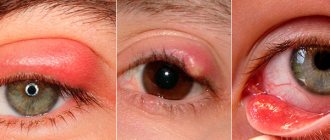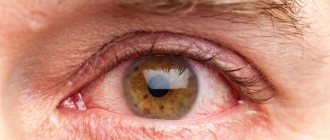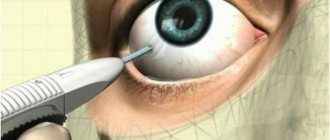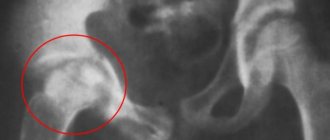What is the conjunctiva
This is the mucous membrane of the eye, which is located too close to the outer part of the organs of vision, therefore it is more susceptible to damage by pathogens. The inflammatory process on it is called conjunctivitis.
When everything is fine with the immune system, pathogenic microorganisms are washed away by tears, which have disinfecting properties. When the protective forces weaken, the liquid changes its composition and loses this effect. Therefore, when pathogens enter the body, they immediately begin life activity.
Duration of bacterial conjunctivitis
The disease begins with the contact of pathogenic bacteria (staphylococcus, pneumococcus, gonococcus and chlamydia) on the protective mucous membrane of the organ of vision.
Staphylococcal infection
One of the common forms of bacteria that provokes conjunctivitis in people with suppressed immunity. The main features are:
- sticky eyelashes in the morning;
- abundant purulent compartments.
Inflammation of this type of disease with adequate therapy can be treated in a short time. The healing process takes 5–6 days.
Pneumococcal infection
Conjunctivitis caused by this pathogenic microbe is expressed most acutely:
- significant swelling of the eyelids and the protective mucous layer of the eye;
- a sharp increase in temperature;
- grayish purulent discharge.
Classification
Conjunctivitis is usually divided into acute and chronic forms. The latter type does not go away for a long time and is difficult to treat. It has two stages - exacerbation and remission.
In the first case, the cornea becomes cloudy, because of this the child feels discomfort, becomes whiny and irritable. During remission, the symptoms go away, but not for long. At the slightest weakening of the immune system, the inflammatory process again makes itself felt.
Acute form
The incubation period of the acute form lasts on average 3-5 days. After this, symptoms appear. Acute conjunctivitis is classified as follows (depending on the cause):
- viral;
- bacterial;
- allergic.
Expert opinion
Ermolaeva Tatyana Borisovna
Ophthalmologist of the highest category, Candidate of Medical Sciences
Note! There is also fungal conjunctivitis, but it is often not isolated into a separate group, but is classified as a bacterial form.
Treatment
In most cases, with the exception of chronic ones, treatment is successful and complications are rare. To the question of how to treat conjunctivitis, you can answer this: for mild forms, folk remedies are excellent; for more complex forms, it is important to consult a doctor in time and undergo a full course of diagnostics and therapy.
Depending on the type, conjunctivitis is cured in the following ways:
- The bacterial infection goes away after a course of tetracycline-based antibiotics. For treatment, medications such as ofloxacin, ciprofloxacin, and lomefloxacin are prescribed.
- Staphylococcal infection goes away after washing with antiseptic agents (furatsilin).
- Eye drops with a 0.05% solution of deoxyribonuclease or a solution of 20-30% sodium sulfacyl help overcome the virus.
- Allergies are treated with specially prescribed antihistamines
Causes
The cause of viral conjunctivitis is the penetration of the following pathogens into the mucosa:
- adenoviruses;
- herpes simplex virus;
- enteroviruses;
- pathogens of influenza, measles, rubella, chickenpox;
- molluscum contagiosum.
Expert opinion
Ermolaeva Tatyana Borisovna
Ophthalmologist of the highest category, Candidate of Medical Sciences
Note! Viral conjunctivitis most often develops against the background of colds. For example, with FLU, tonsillitis and runny nose. How many days conjunctivitis lasts in children depends on the state of the immune system and concomitant diseases.
If the pathogen is an allergen
This form of conjunctivitis is a response to contact with an allergen. Divided into the following types:
- Seasonal. Flowering plants become provocateurs. It’s difficult to say how long it will take for this disease to go away, because... Treatment consists of preventing contact with the allergen. This is quite problematic to do in spring and summer, because... pollen can get in during a walk or even when airing a room.
- Year-round. In this case, the provocateurs are wool, dust, feathers, food, etc. How long it takes to treat conjunctivitis depends on how quickly you can eliminate contact with histamine. For example, if you are allergic to dust, you need to carry out wet cleaning daily, preferably several times a day.
- Giant papillary. Occurs as a result of penetration of a foreign object into the eyes, triggering an allergic reaction.
How long the incubation period lasts depends on the individual characteristics of the child. That is, his predisposition to an allergic reaction. As a rule, no more than 15-30 minutes elapse between contact with histamine and the first symptoms.
Bacterial pathologies
The causative agents of this form are pneumococci and staphylococci. Bacteria can enter the body due to poor hygiene.
Rapid development should not be expected. Incubation can last a long time, several weeks or even months. Pathogens will begin their active development when the immune system is weakened.
Rice. 2. What does bacterial conjunctivitis look like?
Time required to treat an allergic form of the disease
The allergic form of the disease is diagnosed in approximately 20% of the population; it is caused by allergen irritants, both external and internal. Sometimes this form of the disease is caused by taking certain medications. The peculiarity is that two eyes are affected at once, the course is not the most severe, but long-lasting. Atopic conjunctivitis is not contagious, but unpleasant, so it should also be treated.
All prescriptions for this form of the disease are made by an ophthalmologist together with an allergist or dermatologist. It is important to determine exactly what causes the disease, take into account all the accompanying symptoms, the general condition of the patient, and only then determine a treatment regimen. It consists of several stages:
- To begin with, you should exclude any contact with the allergen irritant.
- Then a course of complex therapy is prescribed, including the use of antihistamine eye drops and herbal remedies for oral administration.
- For severe allergic conjunctivitis, corticosteroid drugs are prescribed. They are used only in the most severe cases, when conventional antihistamines have not given the expected result.
The full course of therapy may take up to 10–14 days.
Important: some anti-allergy drugs are not used in pediatrics, therefore all prescriptions for children under 12 years of age must be made strictly by a doctor. If steroid medications were used, they should be discontinued gradually. It is quite possible to cure conjunctivitis of this form; you just need to contact an ophthalmologist and allergist in time and strictly follow all the recommendations.
How can you get infected?
The bacterial infection is transmitted through household contact. For example, when touching an infected person with your hands, using his personal belongings (towel, bed linen, etc.). That is why you need to wash your hands as often as possible, especially after visiting public places.
Viral conjunctivitis is transmitted through household contact and airborne droplets. Therefore, for infection to take place for a long enough time at a close distance from the infected person. The viral form can cause an epidemic, because spreads quickly.
Allergic conjunctivitis is not contagious. Therefore, the child can calmly communicate with other people without posing a threat to them.
In kindergarten
Very often children bring conjunctivitis from kindergarten. If parents do not leave a sick child at home, then there is a high probability that most of the group will become infected.
Moreover, this applies to both viral and bacterial forms of the inflammatory process. Therefore, if irresponsible adults do send your child to kindergarten, it is better to leave your child at home.
Chlamydial conjunctivitis in children
Microorganisms enter the surface of the baby's eye mucosa through contact and household contact.
Most often, children experience unpleasant symptoms after going to a public bath. The source of infection may be the water in the pool. Harmful bacteria, when multiplying, produce viscous mucus that constantly leaks from the eyes. When dried, a dense substance is formed that glues the patient's eyelids together. The danger of infection is that it can affect the mucous membrane of the eyes of newborns. The immune system of infants is not able to fight pathogenic microorganisms. In babies, on the 2nd day after infection, an inflammatory process begins that affects the fold of the lower eyelid. Purulent contents begin to leak from the eyes, which when dry turn into a yellow-gray crust.
Treatment for chlamydial conjunctivitis in children can last for 2-3 weeks.
Signs and symptoms
The following symptoms are typical for childhood conjunctivitis:
- itching, burning, desire to scratch the eyes;
- rapid visual fatigue;
- fear of bright light, eyelids cannot open fully in the sun;
- purulent or clear discharge;
- sticking of eyelids after sleep;
- dry crusts on the corners of the eyes;
- redness of the whites and swelling of the eyelids;
- sensation of a foreign object in the eyes.
Against the background of general intoxication of the body, a high temperature rises, the child constantly feels sleepy, and feels tired immediately after waking up. With conjunctivitis, all of the listed signs do not always appear; they may only partially appear.
Rice. 3. Swelling of the lower eyelid of one eye due to conjunctivitis.
Duration of viral conjunctivitis
Viral conjunctivitis is provoked by colds and other diseases of the upper respiratory tract (ARVI, acute respiratory infections). Significant factors in infectious inflammation are:
- continuous irritation, increasing redness and eye fatigue;
- swelling of the eyelids;
- high sensitivity;
- uncontrolled tearing;
- formation of discharge;
- glued eyelids in the morning.
It is considered an extremely dangerous and contagious form of infectious mucous membrane of the organ of vision. Moves easily through contact from a sick person to a healthy person. Ways of transmission of conjunctivitis:
- communication with the patient;
- aerogenic;
- general household and hygiene items.
Or maybe it’s not conjunctivitis at all
The symptoms of conjunctivitis are quite similar to dacryocystitis in the initial stages of development. This is a disease in which the tear duct becomes blocked. This pathological condition most often occurs in infants.
Often parents begin to treat conjunctivitis, but in fact the child has dacryocystitis. Eye drops do not help in this case; a lump appears in the inner corner.
After this, it becomes clear that it is not the baby’s mucous membrane that is affected, but the lacrimal sac. That is why, at the first signs of eye damage, you should immediately contact a medical institution for help, and not try to make a diagnosis yourself. If treated incorrectly, dacryocystitis can lead to serious complications.
Rice. 4. Dacryocystitis in an infant.
How long does it take to get rid of an illness?
The inflammatory process will not go away on its own; it must be treated. Otherwise, adverse consequences may occur, including blindness. How long the disease is treated depends on the strength of the body’s immunity, the correctness of the chosen therapy regimen, and the implementation of all recommendations and doctor’s orders. On average, inflammation goes away within 3 weeks. In some cases, it may take less time.
Expert opinion
Ermolaeva Tatyana Borisovna
Ophthalmologist of the highest category, Candidate of Medical Sciences
Attention! If conjunctivitis does not go away within a month, then you need to urgently sound the alarm, because... further complications may begin.
How long does it take to treat the viral form?
This type of conjunctivitis takes about 7 days to cure. If no passing symptoms are observed during this period, the symptoms remain or even worsen, you should immediately consult a doctor.
He will examine the child and change the treatment regimen. Most likely, conjunctivitis does not go away due to incorrect treatment tactics.
Duration of bacterial disease
Bacterial conjunctivitis is quite difficult to cure. Sometimes the duration of the disease can exceed 3 months. This is often observed in children with weakened immune systems.
Traumatic form
This form of conjunctivitis occurs as a result of foreign objects, dust, chemicals, etc. getting into the eyes. You need to be prepared for the fact that it is not cured quickly. This usually takes several months. If medications do not help, surgery is the only option.
How long does it take to treat an allergic form?
The duration of the allergic form of the disease depends on how quickly the histamine that caused the pathological condition can be identified and this contact can be prevented. Next, therapy is aimed at eliminating symptoms. The course of treatment lasts at least 10-14 days.
How long does it take to treat a bacterial form of the disease?
Inflammation caused by bacteria requires the use of antibiotics only in extreme cases; regular eye rinsing with antiseptic solutions is usually sufficient. The causative agents of this form of pathology are most often staphylococci. It takes 5–6 days to completely suppress the proliferation of pathogenic microflora and relieve unpleasant symptoms.
Pharmacies offer a wide range of antiseptic, anti-inflammatory and antibacterial drops; choosing the best ones for any form of disease will not be difficult
It is more difficult to treat eye disease caused by the introduction of pneumococci. In this case, the symptoms listed above are very pronounced, the purulent discharge has a gray tint, the eyelids and mucous membranes swell significantly, and the body temperature may rise. Treatment involves the use of anti-inflammatory and antibacterial agents, so that the pathological process completely passes and the mucous membrane recovers, it will take up to two weeks.
The most dangerous and severe form of the disease is considered to be the bacterial form of the disease caused by gonococci. Adults become infected with it through contact from a sick person, usually through household and hygiene items. Newborns can become infected with gonococci when passing through the birth canal if the mother has gonorrhea at the time of birth. Without qualified help, the baby may lose an eye, so at the first symptoms you need to immediately contact an ophthalmologist. Treatment is carried out strictly in a hospital setting; complete recovery will take about two months.
Usually conjunctivitis is treated at home, only in the most serious cases is the patient placed in a hospital setting
If the inflammation is caused by chlamydia, only topical antibiotics in the form of drops or ointments are used; other means will be ineffective. Typically, drops are used during the day, and ointment is applied to both eyes at night, even if only one is affected. This is due to the fact that chlamydial conjunctivitis tends to spread to the other eye a few days after the onset of the inflammatory process. The course of treatment lasts up to 15 days.
Diagnostics
The initial examination is carried out by an ophthalmologist. Additionally, he may involve an allergist, immunologist, surgeon and pediatrician. The ophthalmologist performs a visual examination of the organs of vision with lateral illumination and using a three-mirror Goldmann lens. Laboratory tests are also prescribed:
- cytological;
- serological;
- bacteriological,
- immunological.
If it is determined that the pathological condition is provoked by allergens, then special tests will be prescribed to determine the type of histamine.
Expert opinion
Ermolaeva Tatyana Borisovna
Ophthalmologist of the highest category, Candidate of Medical Sciences
For reference! Laboratory tests help not only to identify the pathogen, but also to determine its quantity and sensitivity to drugs.
How to treat
Treatment will vary depending on the form of conjunctivitis. The doctor must select the treatment regimen.
General principles
In most cases, treatment is carried out on an outpatient basis. Hospitalization may be necessary when the baby’s condition is extremely serious, but this happens rarely. The doctor prescribes eye rinsing. This is a mandatory procedure that must be performed at least 5-6 times a day, incl. before each use of medication.
Medicines are prescribed in the form of drops and ointments. Antiviral and antibacterial medications are used. For allergic conjunctivitis, antihistamine drops and oral tablets are prescribed.
It is not advisable to bathe the child during treatment. You can wipe with wet wipes or a towel soaked in warm water. Walking is allowed, but not in frosty or windy weather. In bright sunshine, protect the child's face.
Drug therapy (medicines for treatment)
For viral conjunctivitis, the following drops and ointments are prescribed:
- Albucid;
- Poludan;
- Aktipol;
- Florenal;
- Zovirax;
- Virolex.
For the bacterial form, the following medications are prescribed:
- Tsiprolet;
- Vitabact;
- erythromycin ointment;
- tetracycline ointment.
For allergic conjunctivitis, antihistamine drops are prescribed depending on the age of the child (Zyrtec, Zodak and others).
Folk remedies for treatment
It is important to understand that alternative medicine is not able to destroy the pathogen, they only alleviate the symptoms. Before using them, in any case, consult a doctor.
Colloidal silver
This remedy helps with the bacterial form. You need to instill 2 drops into each eye twice a day for two days.
Carrot
Juice from carrots and parsley in a ratio of 3 to 1 helps with inflammation of the mucous membrane. The drink should be consumed half a glass three times a day before meals until complete healing.
Tea brewing
It is recommended to wash your eyes with weak tea leaves. The procedure is performed every 3 hours.
Chronic conjunctivitis
Treatment of chronic conjunctivitis comes down to eliminating the underlying disease that caused the pathology and strengthening the immune system. To relieve inflammatory processes, zinc sulfate in the form of drops and a 1% resorcinol solution can be used. Before going to bed, you can put yellow mercury ointment behind your eyelid - it has anti-inflammatory, antiseptic and disinfectant effects.
It is strictly forbidden to use bandages for any form of conjunctivitis. A closed environment and the absence of oxygen can create a favorable breeding ground for the proliferation of bacteria and microbes, which will lead to a deterioration in the patient’s condition and the spread of bacterial flora on the mucous membrane of the eye.
It is strictly forbidden to use bandages for any forms of conjunctivitis.
Prevention
To prevent the development of conjunctivitis, you must follow the following recommendations:
- protect the child from people who have symptoms of colds or eye lesions (including not taking them to kindergarten if someone in the group is sick);
- teach compliance with hygiene rules;
- exercise daily and take walks in the fresh air;
- provide rational nutrition;
- carry out hardening procedures;
- do wet cleaning daily, ventilate the rooms several times;
- avoid contact with allergens;
- promptly treat concomitant diseases.
To summarize, we can conclude that conjunctivitis is a treatable disease. The duration of therapeutic measures depends on various factors. If treatment is started on time and chosen correctly by the doctor, the prognosis will be favorable. It will be possible to avoid complications and completely get rid of the infection.
How is conjunctivitis diagnosed?
The diagnosis of conjunctivitis is established by an ophthalmologist after examining the patient.
In order to determine its most likely cause, the doctor will ask the patient about past illnesses and working conditions. Sometimes an additional analysis of the discharge from the eye is performed to determine the pathogen. In some cases, consultation with other specialists (urologist, gynecologist, allergist) may also be required.
In the case of a mild form, the most serious problem is not the disease itself, but its easy spread. Strict adherence to hygiene will reduce the risk of infection spreading to the second eye and infecting others.











